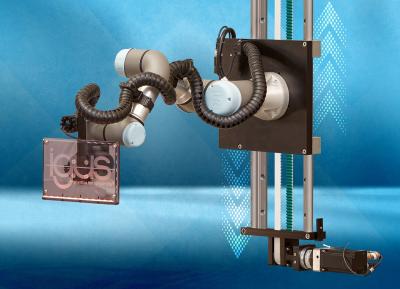
igus now offers a ready-to-connect 7th axis that will allow a robot to move over a distance several meters and includes a maintenance-free drylin ZLW toothed belt axis with a corresponding adapter plate, switch cabinet, cables, and software integration.
For easy integration of the axis and the robot, igus has developed two adapter kits for robolink and UR robots. They enable fast and cost-effective low-cost automation. Germany-based igus, the low-cost, highly-technical, and sustainability-focused motion plastics specialist, runs its North American operations out of Providence, R.I.
Robots insert workpieces into a milling machine, dispense chocolate bars from vending machines and place crates on pallets, which are then stacked. But how can they move vertically, horizontally or overhead in a flexible manner? The answer is a 7th axis. Specifically, for linear adjustment, igus has developed a lubrication-free, lightweight flat axis with a stroke of up to 6m and a positioning accuracy of 0.5mm with the help of its drylin linear construction kit.
To ensure that the axis can be easily combined with a robot, igus now offers overall solutions for UR3, UR5 and UR10 robots (Universal Robots), robolink DP robots and DCi robots. "A customer who acquires the new complete system receives, on the one hand, an adapter plate for easy attachment of the robot and the energy chain to the axis and, on the other, the corresponding integration solution, in other words the switch cabinet with cables, motor controller and the respective software solution," said Alexander Mühlens, Head of Automation Technology at igus GmbH. "If a robolink robot is used, the 7th axis can be easily controlled by means of the igus robot control software. For UR robots, we supply a UR-CAP as a direct integration solution, including all the electrical modules needed." This means that the robot can be installed and put to work within just a few minutes.
Ready-to-connect 7th axis in desired length
Users can configure the appropriate complete solution online at https://www.igus.com/info/7th-axis-for-universal-robots. The 7th axis is supplied by igus as a complete system that is ready to connect immediately, consisting of a drylin ZLW-20 toothed belt axis in the desired length exactly to the millimeter, plus the connecting cables, the switch cabinet, the power electronics, the software integration and the corresponding adapter set. Alternatively, the adapter set is separately available consisting of an adapter plate and control system.
Contact Details
Related Glossary Terms
- flat ( screw flat)
flat ( screw flat)
Flat surface machined into the shank of a cutting tool for enhanced holding of the tool.
- gang cutting ( milling)
gang cutting ( milling)
Machining with several cutters mounted on a single arbor, generally for simultaneous cutting.
- milling
milling
Machining operation in which metal or other material is removed by applying power to a rotating cutter. In vertical milling, the cutting tool is mounted vertically on the spindle. In horizontal milling, the cutting tool is mounted horizontally, either directly on the spindle or on an arbor. Horizontal milling is further broken down into conventional milling, where the cutter rotates opposite the direction of feed, or “up” into the workpiece; and climb milling, where the cutter rotates in the direction of feed, or “down” into the workpiece. Milling operations include plane or surface milling, endmilling, facemilling, angle milling, form milling and profiling.
- milling machine ( mill)
milling machine ( mill)
Runs endmills and arbor-mounted milling cutters. Features include a head with a spindle that drives the cutters; a column, knee and table that provide motion in the three Cartesian axes; and a base that supports the components and houses the cutting-fluid pump and reservoir. The work is mounted on the table and fed into the rotating cutter or endmill to accomplish the milling steps; vertical milling machines also feed endmills into the work by means of a spindle-mounted quill. Models range from small manual machines to big bed-type and duplex mills. All take one of three basic forms: vertical, horizontal or convertible horizontal/vertical. Vertical machines may be knee-type (the table is mounted on a knee that can be elevated) or bed-type (the table is securely supported and only moves horizontally). In general, horizontal machines are bigger and more powerful, while vertical machines are lighter but more versatile and easier to set up and operate.
